While it’s easy to over complicate the game of golf, the goal of each individual shot is rather simple – to hit your target. Whatever the target may be for the shot at hand, your goal is to place the ball as close as possible to that target when all is said and done. You might be aiming for the middle of the fairway, the hole itself, a certain portion of the green, or just about any other spot on the course. By hitting your target, you should set yourself up to finish the hole is as few strokes as possible.
Of course, it sounds simple enough to hit your targets while reading an article online, but doing it in real life is far more complicated. There is plenty that can go wrong, including pulling shots to the left of your target (for a right-handed golfer). If you are going to consistently hit targets, you need to work on removing as many of these kinds of errors as possible. In this article, we are going to explain what it means to hit a pulled shot, why this happens, and what you can do to break the habit.
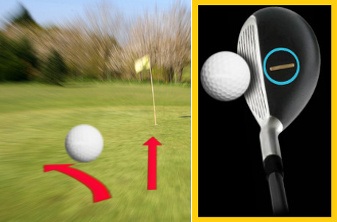
All of the content below is based on a right-handed golfer. If you happen to play left-handed, please take a moment to reverse the directions as necessary.
— What is a Pulled Golf Shot?
| GOLF FIXES BY PGA PROS |
|---|
| What is a Golf Pull Slice Shot and How to Fix It | Video | Article |
| Pull the Right Foot and Shoulder Back to Cure Slice | Video | Article |
| What is a Golf Pull Slice Shot and How to Fix this Problem Golf Shot Swing tip for Senior Golfers | Video | Article |
| Pull Down The Right Elbow To Stop Casting During The Golf Swing | Video | Article |
| Pull Hook, Causes and Cures Golf | Video | Article |
| Pull Slice, Causes and Cures Golf | Video | Article |
| Pull Slice, What Is It And How to Cure This Problem Golf Swing | Video | Article |
| Dealing With The Golf Pull Hook Part Three | Video | Article |
| What are Pull Hooks and How to Cure this Golf Shot as a Senior Golfer | Video | Article |
| A Three Step Process To Improve Golf Pull Slice Shots | Video | Article |
| Does The Pull Sliced Need To Be Fixed For Better Golf | Video | Article |
| Pull Down Right Elbow to Stop Casting Club | Video | Article |
| What are Pull Hooks and How to Correct this Problem for Women Golfers | Video | Article |
| Tips to Fix and Correct a Pulled Golf Shot – Golf Swing Tip for Women | Video | Article |
| Adjustments To Stop A Pulled Knock Down Golf Shot | Video | Article |
| Tips to Cure Your Pulled Golf Shot | Video | Article |
| LESSONS |
|---|
| Is The Golf Pull Slice Playable | Video | Article |
| The Pull Golf Swing Fault by Tom Stickney | Video | Article |
| Creating A Golf Pull Slice | Video | Article |
| Getting Around The Golf Course With A Pull Slice | Video | Article |
| Does Your Over The Top Produce A Pull Or Slice | Video | Article |
| PRACTICE DRILLS |
|---|
| Understanding Pulled Golf Shots | Video | Article |
| Use Correct Sequencing To Avoid A Pulled Golf Shot | Video | Article |
| GOLF QUESTIONS |
|---|
| How Can I Stop Pull Sliced Golf Shots? | Video | Article |
| What Causes a Golf Pull Hook Shot? | Video | Article |
| What Causes a Golf Pull Slice Shot? | Video | Article |
| How Can I cure my Pull Slice Shot? | Video | Article |
You may already know that a pulled shot is one that misses your target to the left. But are all shots that miss to the left considered pulled? Not necessarily. A pull is a shot that starts to the left of the target and then flies mostly straight until it lands. This is different from a hook, which also misses to the left, but curves dramatically from right to left in the air as it flies. It’s important to know the difference between a pull and a hook, because the root causes of these errors are different. Also, it’s worth noting that you can hit a pull-hook, which is a shot that starts to the left of the target and then hooks even farther left, but that is a topic for another article.
So, if you strike a shot and look up to see the ball immediately heading left of where you had intended, it’s safe to assume that you hit a pull. But what has to happen for a pull to occur? Let’s look at the two key elements of a pull from a technical perspective.
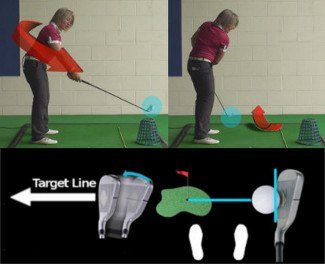
- Swinging across the target line. To hit a pull, you will need to swing the club across the target line from outside-in. In other words, as you swing through the hitting area, the club will gradually be getting closer to your body. There are underlying mechanical issues that can cause a golfer to swing from outside-in, and we will get to those in the next section. For now, just understand that you aren’t going to be able to hit a straight pull without this outside-in swing path. If you suspect that you might be swinging from outside-in, check the direction of your divot after hitting an iron shot. If your divot is pointed to the left of the intended target, you’ve swung across the line through impact. It’s a good idea to monitor your divots regularly to make sure nothing is going wrong with your swing path.
- Club face square to the swing path. In order to hit a straight shot, your club face needs to be square to your swing path at the moment of impact. This is true of any kind of shot, whether it is a pull or a shot that flies directly at your target. To hit a pull, your club face will need to be in a position that is closed relatively to the intended target line, but roughly square to the actual swing path. That will keep sidespin to a minimum, causing the ball to fly mostly straight as it heads off to the left of your target. It is the combination of an outside-in swing path and a club face that is square to the path which will add up to a pulled shot when all is said and done.
Pulled shots are frustrating for a variety of reasons. For one thing, you will know the shot is off-line as soon as you look up after impact, so you won’t even have a moment to hope that the ball ends up near the target. Also, if you hit the ball solidly when you hit a pull, it’s likely to fly quite a bit farther than you had intended, because you will have taken some of the loft off the club. So, not only are you going to miss the target to the left, but you’ll also be long of your intended distance and may be in a tough spot from which to recover. While it’s not reasonable to expect that you can wipe pulled shots completely out of your game, you can reduce their frequency by improving your technique. We’ll start to tackle that topic in the next section.
— Why Golfers Hit Pulls
At this point, we have established what it is that causes the ball to be pulled to the left, but we haven’t discussed what you might be doing in your swing to make that happen. In other words, why are you swinging across the target line with a club face that is square to that path? Once you figure out what is going wrong with your swing, you can get down to work on making the necessary corrections.
While you’ll need to evaluate your own swing technique to figure out what is going wrong, the points below are a good place to start.
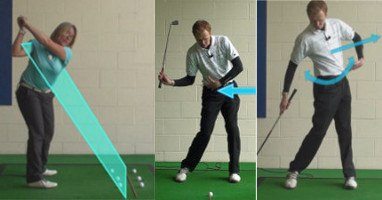
- An inside takeaway. It is often said that golf is a game of opposites, and that is certainly true here. If you are swinging from outside-in through the hitting area, it may be because you are swinging too far to the inside on the way back. That might seem a little counter intuitive, but it makes perfect sense when you think through how the swing develops. If your takeaway moves too far to the inside, you’ll be crowded during the backswing and the club will be very close to your body at the top. From there, you’ll have to push the club up and away from your body in the transition just to make room for the downswing – and that action is going to put the club outside of the proper path. This is commonly known as an ‘over the top’ move, and it can lead to a slice as well as a pull. In fact, the only real difference between a slice and a pull is the position of the club face at impact. With the pull, the face is square to the swing path when you strike the ball. When you hit a fade, the face is wide open at impact. If you have been dealing with either a slice or a pull – or maybe a bit of both – consider the possibility that your takeaway is to blame. If you improve the path of the club going back, you might be able to eliminate your over the top move and straighten out your swing path.
- Poor rotation in the downswing. You may find yourself hitting a pull even if there is nothing at all wrong with your takeaway. When that happens, you’ll want to look to your downswing rotation as a potential cause of the problem. In a healthy golf swing, the downswing action involves an aggressive turn of the lower body through the hitting area. In fact, it should be the lower body that starts the downswing, with the club trailing behind and picking up speed as it heads down toward impact. Unfortunately, many players fail to get things going with their lower body during the transition, instead just using their arms to pull the club down to the ball. When you make this common mistake, a couple of negative outcomes are likely. For one thing, your swing will lack speed, since you haven’t used the big muscles of your lower body to help generate power. Also, and perhaps more importantly, you are likely to swing on an outside-in path because your lower body never cleared out of the way. With your lower body staying in place, your arms and the club may need to move a bit outside just to find a path toward impact. In the end, you’ll swing across from outside-in and either hit a pull or a slice, depending on the position of the club face.
- A rushed tempo. Our last point in this list relates to the tempo of your swing rather than the positions that you find along the way. Tempo is an underrated piece of the overall golf swing puzzle, so be sure to pay attention to this point as you practice. Specifically, if you are hitting pulls, you might be rushing through your swing. If you hurry, you are likely to cut your backswing a bit short as you rush into the transition and then the downswing. When that happens, you don’t get all the way behind the ball at the top of your swing, and you might swing across from outside-in as a result. Remember, the golf ball isn’t going anywhere, so take as much time as you need to get through your swing. By taking just a bit of extra time during the backswing phase, you might find yourself in a much better position when swinging down toward impact.
So, why are you currently dealing with pulled shots? Well, we can’t tell, since we can’t see you swing the club. It’s going to be up to you to figure out where your swing is going wrong, which you should be able to do now that you have some idea of what to look for. Of course, if you are still having trouble getting to the bottom of this issue, working with a local golf professional on your swing might be a good idea. Working one-on-one with a pro can help you understand the mechanics of your swing and where they need to be improved.
— Moving Away from This Mistake
It’s time to get down to the business of fixing your pulled shots. We’ve talked thoroughly about the mechanics of why shots are pulled and what may be happening in your swing to make it happen, but now let’s turn our attention to actually moving the ball back closer to the target.
The tricky thing about providing you with advice on how to get away from pulled shots is that we don’t know exactly what you are doing wrong to hit those pulls. As we mentioned above, you’ll have to sort that out for yourself, or with the help of a local teaching pro. However, the tips below will apply to many golfers, so read through them and decide if you want to give any of these ideas a try for yourself.
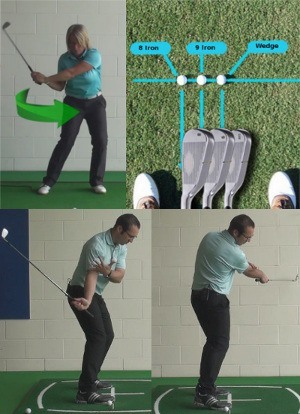
- Commit to the downswing. We mentioned above that you can wind up hitting a pull if you fail to rotate properly in the downswing. While that can be a mechanical issue that needs to be corrected, it can also stem from nothing more than a lack of confidence in the shot you are hitting. If you aren’t fully committed to the shot at hand, you might fail to rotate in the downswing while carefully trying to guide the club into the ball. That just isn’t going to work. You need to swing aggressively and with as much confidence as you can muster. If you think the basic fundamentals of your swing are sound yet you keep hitting pulls out on the course, it might be that you simply need to do a better job of committing to your shots.
- Quiet down your right hand. Some players who deal with a pull struggle with using their right hand too actively in the transition and into the downswing. When your right hand does more than it should, you can wind up swinging across the line and shutting the club face down at impact. This is the perfect recipe for a pull. From the top of your swing, feel like it is the butt end of the club that is swinging down toward the ball, while your right hand doesn’t do much other than hold on for the ride. That right hand will get involved at impact, but by then you will hopefully be in a good position to deliver a powerful strike and send the ball toward the target. An overactive right hand in the downswing is something that plagues many golfers, so don’t feel bad if this issue gets in your way. To work on improving in this area, try hitting some soft pitch shots at the range while keeping your right hand almost completely passive. Then, work your way up into longer and longer shots, only letting your right hand do what is needed to square the face at impact. Specifically, if you can keep the right hand quiet and passive during the transition phase, you’ll be much more likely to stay away from the pulls.
- Check on your ball position. Another factor that can contribute to pulled shots is poor ball position. If you play the ball too far forward in your stance, you might wind up shutting down the club before you reach impact and pulling the shot to the left. It won’t work that way for every golfer, as some will hit a fade or a slice with a forward ball position, but this is a point worth checking on anyway. The best way to find the right ball position for your game is just to experiment on the range until you find a spot that seems to lead to good results.
There are no shortcuts in golf, so expect to spend some time on the practice range working on your technique if you are going to reduce the number off pulled shots in your game. Also, these kinds of things can take time to improve, so don’t get too frustrated if you don’t see progress right away. Stick with it and keep the big picture in mind as you work on improving your swing.
— Pulled Shots in the Short Game
You can pull shots in the short game just like you can in the long game, and making this mistake when you are so close to the hole can be even more frustrating. For instance, if you have a flat three-foot putt and pull it to the left for a costly miss, you’ll be cursing yourself all the way to the next tee. Of course, getting frustrated with yourself isn’t going to do much good, so you might as well set that emotion to the side and get down to work on your technique. We’d like to use the points below to talk about pulled shots in three different short game categories – putting, chipping, and pitching.
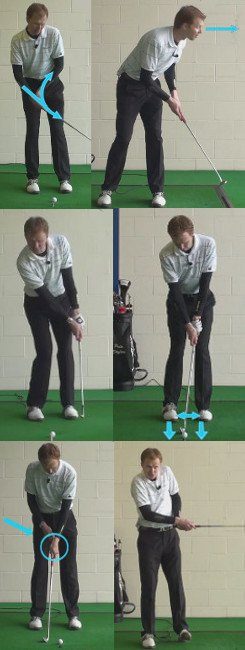
- Putting. There are a couple of potential causes of pulled putts. For one thing, you could be using your right hand too actively during the forward portion of the stroke, which could close the blade and cause the ball to miss to the left. Also, you could be pulling your head up out of the stroke early, which would take your shoulders with it and again cause the putter to close. If it is your right hand that’s the problem, try hitting some practice putts with your left hand only. That type of practice will teach you to control the putting stroke with the big muscles by rocking your shoulders while your hands stay out of it. If it seems to be early head movement that is the problem, practice hitting some putts where you never look up at all – you just listen for the ball to go in. You don’t have to be that extreme in terms of keeping your head down while putting on the course, but this is a handy drill to teach yourself the importance of keeping your head still throughout your stroke.
- Chipping. If you seem to be missing your chip shots to the left of the intended target over and over again, check your ball position. There is a good chance that this shot pattern can be blamed on poor ball position – specifically, placing the ball too far forward in your stance. Since there isn’t much in the way of body movement on a chip shot, you are going to have trouble reaching the ball if it is way up in your stance. As a result, the face will probably be closed by the time you get to impact, and the shot will miss left. Even moving the ball back just an inch or two can have a big impact on your accuracy.
- Pitching. Pulled pitch shots may be the result of an overactive right hand, just as we had discussed earlier regarding the full swing. Many golfers get nervous while hitting pitch shots and they use their right hand a little too much in an effort to get the shot up off the ground. Don’t fall into that trap. The loft on your club will get the ball off the ground for you, so just stay down through impact with an aggressive, descending blow. This technique will help you make better contact and it will also help you keep the ball on line.
For as long as you continue to play golf, you will continue to hit pulled shots from time to time. No one is perfect in this game, so completely eliminating these kinds of errors just isn’t realistic. What you can strive for, however, is to cut down on the frequency of your mistakes. By hitting fewer pulled shots, you should leave your ball near the target more often and shoot lower scores as a result. Thanks for reading and good luck!






